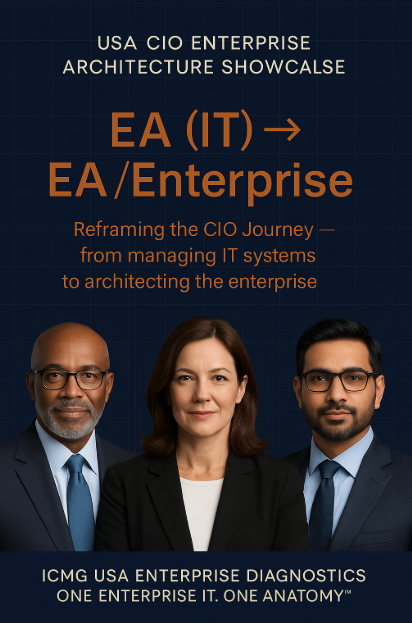Reframing the CIO Journey — From Managing IT Systems to Architecting the Enterprise
- Sunil Dutt Jha

- Nov 3
- 3 min read
1. The Turning Point for CIOs
For decades, CIOs were defined by technology operations. Their success measured by uptime, budget control, and IT service continuity. But as enterprises became interconnected ecosystems, those measures stopped being enough.
The question is no longer “Are systems running?” It’s “Is the enterprise running coherently?”
That is the shift — from managing IT systems to architecting the enterprise.
2. The Enterprise Anatomy Framework
Every enterprise operates through six structural layers (P1–P6). ICMG’s Enterprise Anatomy Model defines these precisely.
Perspective | Description |
P1 – Strategy | Direction and value outcomes to achieve. |
P2 – Process | Sequence of business activities realizing strategy. |
P3 – System / Logic | Data, rule, and function systems that enforce business flow. |
P4 – Component Specifications | APIs, datasets, screens, and configurations that make those systems. |
P5 – Implementation Tasks | Human and IT tasks that build or modify components. |
P6 – Operations | Business and IT operations that maintain service continuity. |
Traditionally, CIOs worked primarily in P4–P6. The new design leadership begins when they take ownership of P1–P3, aligning system logic with business intent.
3. From Custodianship to Structural Ownership
Crossing this bridge transforms the CIO’s daily purpose.
Perspective | Old Role | New Design Role |
P1 – Strategy | Align IT spend. | Architect enterprise value flow. |
P2 – Process | Automate workflows. | Redesign processes as structural modules. |
P3 – Logic | Integrate apps. | Harmonize decision logic across functions. |
P4 – Components | Standardize APIs. | Define canonical enterprise components. |
P5 – Implementation | Deliver projects. | Govern by architectural gates. |
P6 – Operations | Maintain uptime. | Monitor continuity metrics. |
This is what it means to move from EA (IT) to EA (Enterprise) — from infrastructure control to structural coherence.

4. What “Chief Design Officer” Means in Practice
Design, in the Anatomy sense, is not visual. It is structural. It ensures that every enterprise layer references a single, consistent logic tree.
The CIO becomes Chief Design Officer when they can:
Trace any operational issue to a missing or conflicting P-layer connection.
Represent the enterprise in design diagrams, not just infrastructure charts.
Govern budgets and programs through anatomical conformance, not milestones.
Chief Design Officer = Chief Anatomy Integrator.
5. How This Changes Daily Work
Once the CIO assumes this structural role, daily work changes form:
Meetings: Move from project-status reviews to cross-P1–P6 structural reviews.
Metrics: Replace “system uptime” with a Design Continuity Index that measures structural flow.
Language: Replace “project completion” with “anatomy alignment.”
Teams: Create hybrid roles — Logic Architects (P3–P4) and Continuity Analysts (P5–P6) — operating within the enterprise design function.
This is not added complexity. It is the removal of fragmentation.
6. The Enterprise Anatomy Bridge as the New Operating Model
Operating through enterprise anatomy changes how the CIO sees the organization. The enterprise behaves like a living system:
Strategy (P1) — the nervous system transmitting intent.
Processes (P2) — the muscle sequences executing that intent.
Logic (P3) — the neural maps coordinating the flow.
Components (P4) — the organs performing specific functions.
Implementation (P5) — the growth and repair mechanism.
Operations (P6) — the vital functions sustaining life.
When one layer fails, the others adapt or fail in sequence. The CIO’s architecture model becomes the diagnostic lens of this organism — identifying where enterprise health is structurally broken.
7. The CIO as Chief Anatomy Integrator
Being Chief Design Officer is not about rank. It is about structural accountability. No decision, process, or system should exist outside the body of enterprise logic.
It means:
Owning structure instead of tools.
Designing decisions instead of approving technology.
Building health instead of fixing parts.
The CIO becomes the only executive capable of seeing and correcting the enterprise’s internal design errors in real time.
8. ICMG’s CIO Architecture Initiative
ICMG formalizes this shift through three design instruments:
One Enterprise IT. One Anatomy™ — unified decision-logic model connecting business and IT.
100+ Diagnostic Cases — exposing where partial architecture created systemic misalignment.
Think Tank 2025 & Architecture Awards — peer-driven evaluation of enterprise design maturity.
This reframes enterprise architecture as a living anatomy, not static documentation.
9. The Bridge Every CIO Must Cross
Every CIO reaches this bridge. Few cross it.
Those who do, discover that systems stop being cost centers. They become the structure of value.
One Enterprise IT. One Anatomy™
10. 2025 — The Year CIOs Move Beyond IT™
2025 marks the institutionalization of design governance. The CIO who masters enterprise anatomy will not manage technology — they will architect coherence.
2025 is the year CIOs move Beyond IT™, where architecture becomes the core design language of continuity and growth.

